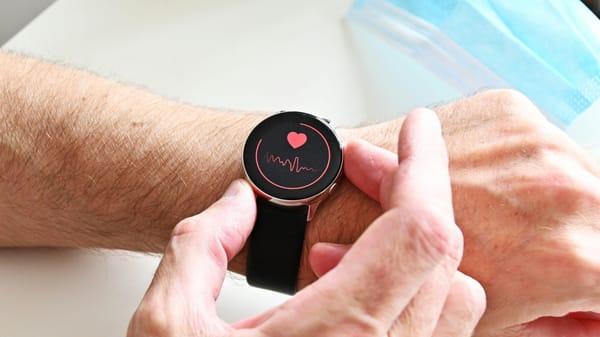How to Regenerate Your Insulin-Producing Cells without Surgery even if You're Over 50
Did you know that pancreatic damage from Type 2 diabetes may be reversible? With advances in treatment and lifestyle changes, restoring pancreatic function is becoming a reality. Join us as we explore the standard of care and the mechanisms behind healing!

Did you know that millions of people with Type 2 diabetes are unknowingly sabotaging their own pancreas, silently waging a war that can be reversed? In fact, research suggests that up to 90% of people with Type 2 diabetes can actually regenerate their pancreas, but only if they adopt the right lifestyle and treatment strategies. What's the secret to unlocking this hidden potential?
Imagine waking up one day to find that your body has turned against you, silently waging a war on your pancreas. This is the reality for millions of people living with Type 2 diabetes, a condition that has reached epidemic proportions worldwide. But what if the damage to your pancreas wasn't a life sentence, but a reversible condition?
In recent years, groundbreaking research has shed new light on the potential for pancreatic healing in Type 2 diabetes. This blog post looks into the world of diabetes management, exploring the standard of care, cutting-edge treatments, and the mechanisms that could hold the key to reversing pancreatic damage.
From lifestyle modifications to an arsenal of medications, we'll revise the multifaceted approach to managing this complex condition. We'll examine the pros and cons of various drug classes, from the tried-and-true metformin to the newer SGLT2 inhibitors and GLP-1 receptor agonists. But beyond just managing symptoms, we'll explore the possibility of actual pancreatic regeneration.
Did you know that your pancreas has an innate ability to heal itself? We'll dive into the fascinating world of beta cell regeneration, stem cell differentiation, and the role of growth factors in pancreatic repair.
Whether you're living with Type 2 diabetes, know someone who is, or are simply curious about the latest advancements in medical science, this article will provide you with valuable insights into the future of diabetes care.
The Multifaceted Approach to Managing Type 2 Diabetes: A Comprehensive Guide to Standard Care
Imagine your body as a complex machine, where every system depends on precise balance and communication. For millions living with Type 2 diabetes, this delicate machinery has gone off-track, creating a mass of metabolic challenges that can feel overwhelming and insurmountable. But what if you could rewrite your health narrative?
The journey of managing Type 2 diabetes is not about limitation, but transformation. Type 2 diabetes management requires a holistic strategy that addresses various aspects of a patient's health and lifestyle. This comprehensive approach aims not only to control blood sugar levels but also to prevent complications and enhance overall quality of life. At the core of this strategy lies the importance of lifestyle modifications. Patients are encouraged to adopt a healthy eating plan, focusing on a diet rich in fruits, vegetables, whole grains, lean proteins, and healthy fats. Regular physical activity is equally crucial, as it helps improve insulin sensitivity and aids in blood sugar control. Weight management is often emphasized, as even modest weight loss can significantly improve glycemic control. At its heart, this approach is about understanding your body's unique language and learning to communicate with it effectively.
While lifestyle changes form the foundation, many patients require medication to achieve optimal blood sugar control. The choice of medication depends on various factors, including the patient's overall health, comorbidities, and individual response to treatment. Medications are not just pills, but precision tools carefully selected to support your body's healing journey. Metformin, often the first line of defense, works like a skilled negotiator, helping your liver reduce glucose production and improving insulin sensitivity. As your treatment evolves, a carefully curated combination of medications can create a personalized strategy that addresses your specific metabolic needs.
Regular monitoring of blood glucose levels is a crucial component of diabetes management. It allows patients and healthcare providers to track treatment effectiveness and make necessary adjustments. The frequency and method of monitoring may vary depending on the individual's treatment plan and level of glycemic control. Patients with Type 2 diabetes should have regular appointments with their healthcare team to monitor their condition, screen for complications, and adjust treatment as needed. These check-ups typically include assessments of glycated hemoglobin (HbA1c), blood pressure, and lipid profiles.
Given the increased risk of cardiovascular disease in patients with Type 2 diabetes, managing blood pressure and cholesterol levels is paramount. This often involves a combination of lifestyle modifications and medications such as statins or antihypertensive drugs. Diabetes self-management education and support (DSMES) programs play a vital role in empowering patients to take an active role in their care. These programs provide valuable information about diabetes management, nutrition, medication adherence, and problem-solving skills. Preventive care shifts from a defensive strategy to a proactive celebration of wellness. Eye exams, foot screenings, and cardiovascular assessments become opportunities to understand and appreciate your body's complexity. Each test is a window into your health, offering insights and potential for intervention.
This isn't just management - it's a revolution. A comprehensive, personalized approach that sees Type 2 diabetes not as a life sentence, but as a challenge to be understood, addressed, and ultimately, transformed. By implementing this multifaceted approach, healthcare providers aim to help patients with Type 2 diabetes achieve optimal glycemic control, reduce the risk of complications, and maintain a high quality of life.
The Diabetes Medication Mosaic: Balancing Benefits and Risks in Type 2 Management
The landscape of Type 2 diabetes management is rich with pharmaceutical options, each offering unique benefits and potential drawbacks. At the foundation lies metformin, a stalwart first-line treatment that reduces liver glucose production and enhances insulin sensitivity. Its affordability, effectiveness, and minimal side effects make it a cornerstone of diabetes care, though gastrointestinal discomfort can occur initially.
Branching out, we find sulfonylureas, which stimulate insulin release from the pancreas. While effective and budget-friendly, they carry risks of hypoglycemia and weight gain. Thiazolidinediones (TZDs) improve insulin sensitivity but come with concerns about fluid retention and cardiovascular risks, limiting their widespread use.
Newer classes of medications offer innovative approaches. DPP-4 inhibitors increase incretin hormone levels, providing moderate glucose control with few side effects. SGLT2 inhibitors promote glucose excretion through urine, offering the added benefits of weight loss and potential cardiovascular protection, albeit with an increased risk of urinary tract infections.
GLP-1 receptor agonists mimic natural hormones to regulate blood sugar, appetite, and digestion. These injectable medications can lead to significant weight loss and cardiovascular benefits, though gastrointestinal side effects are common.
Insulin therapy remains a powerful tool, especially for advanced cases. It directly addresses insulin deficiency but requires careful monitoring to avoid hypoglycemia and weight gain.
The art of diabetes management lies in selecting the right combination of these medications, tailoring treatment to each patient's unique needs, health status, and treatment goals. As our understanding of diabetes pathophysiology evolves, so too does our approach to pharmacological management, with an increasing focus on medications that offer benefits beyond glucose control, such as cardiovascular and renal protection.
The Long Game: Medication Benefits and Pancreatic Healing in Type 2 Diabetes
While medications play a crucial role in managing Type 2 diabetes, long-term use can sometimes lead to side effects that require careful monitoring. Metformin, despite its excellent safety profile, may cause vitamin B12 deficiency in some patients over time. Sulfonylureas and insulin can lead to weight gain and increase the risk of hypoglycemic events. Thiazolidinediones have been associated with an increased risk of bone fractures and, in rare cases, bladder cancer. SGLT2 inhibitors, while offering cardiovascular benefits, may increase the risk of genital infections and diabetic ketoacidosis. GLP-1 receptor agonists can cause persistent gastrointestinal issues in some patients.
Managing these side effects requires a personalized approach. Regular monitoring, dose adjustments, and sometimes switching medications may be necessary. Healthcare providers must balance the benefits of glycemic control against the potential risks of long-term medication use, always considering the patient's overall health and quality of life.
Intriguingly, recent research has shed light on the pancreas's innate capacity for healing and regeneration, offering hope for reversing some of the damage caused by Type 2 diabetes. The pancreas possesses a remarkable ability to regenerate beta cells, the insulin-producing cells destroyed or damaged in diabetes. This regeneration occurs through several mechanisms, including the replication of existing beta cells and the differentiation of pancreatic progenitor cells.
Stem cell differentiation plays a crucial role in this regenerative process. Under the right conditions, pancreatic stem cells can differentiate into new beta cells, potentially restoring insulin production. Neogenesis, the formation of new beta cells from non-beta cells, and angiogenesis, the growth of new blood vessels, also contribute to pancreatic healing.
The inflammatory response, often seen as detrimental in diabetes, can actually play a dual role. While chronic inflammation can damage pancreatic tissue, acute inflammation can trigger repair mechanisms. Extracellular matrix remodeling, the restructuring of the tissue surrounding cells, is another critical component of pancreatic healing, providing the necessary scaffold for new cell growth.
Growth factors, such as glucagon-like peptide-1 (GLP-1) and epidermal growth factor (EGF), play pivotal roles in stimulating beta cell proliferation and survival. Understanding and harnessing these growth factors could lead to new therapeutic approaches for pancreatic regeneration.
The potential for reversing pancreatic damage in Type 2 diabetes offers a paradigm shift in how we approach the disease. While current management strategies focus on controlling symptoms and preventing complications, future treatments may aim to restore pancreatic function. This emphasizes the importance of early intervention and comprehensive management strategies that combine medication, lifestyle modifications, and potentially regenerative therapies.
Healthcare providers must focus on early detection and aggressive management of Type 2 diabetes, leveraging both pharmacological and lifestyle interventions. By doing so, we may not only control the disease but potentially reverse its course, offering patients the hope of a life free from diabetes.
Breaking Free: A Personal Journey Through Type 2 Diabetes
Elliot stared at the array of pill bottles on his kitchen counter, each a stark reminder of his journey with Type 2 diabetes. At 45, he never imagined he'd be managing a chronic illness. The diagnosis had hit him like a freight train two years ago, forcing him to confront years of poor eating habits and a sedentary lifestyle.
Initially overwhelmed, Elliot found hope in his doctor's words: "With the right approach, we can potentially reverse some of the damage to your pancreas." This sparked a fire within him. He dove headfirst into researching diabetes management, determined to reclaim his health.
Gradually, Elliot transformed his life. He swapped fast food for home-cooked meals rich in vegetables and lean proteins. His evening TV sessions gave way to brisk walks and gym visits. The medications, once a source of frustration, became allies in his fight.
Month by month, Elliot's blood sugar levels improved. His energy soared, and he shed pounds. At his latest check-up, his doctor's eyes sparkled with excitement. "Your pancreas is showing signs of healing," she said. For Elliot, it was more than just numbers on a chart – it was proof that his dedication was paying off, one day at a time.
Key Takeaways
- Type 2 diabetes management requires a multifaceted approach, combining lifestyle modifications, medications, regular monitoring, and preventive care.
- Early intervention and comprehensive management strategies are crucial in potentially reversing pancreatic damage in Type 2 diabetes.
- The pancreas has an innate capacity for healing and regeneration, offering hope for reversing some of the damage caused by Type 2 diabetes.
- Mechanisms contributing to pancreatic healing include beta cell regeneration, stem cell differentiation, neogenesis, angiogenesis, and the role of growth factors.
- Long-term use of diabetes medications can lead to side effects, necessitating careful monitoring and personalized treatment adjustments.
- Metformin is often considered the first-line treatment for Type 2 diabetes due to its effectiveness, safety profile, and relatively low cost.
- Newer classes of medications, such as SGLT2 inhibitors and GLP-1 receptor agonists, offer benefits beyond glucose control, including cardiovascular and renal protection.
- Lifestyle modifications, including healthy eating, regular physical activity, and weight management, play a crucial role in diabetes management and potential pancreatic healing.
- Regular medical check-ups and blood sugar monitoring are essential for tracking treatment effectiveness and making necessary adjustments.
- Diabetes self-management education and support (DSMES) programs are vital in empowering patients to take an active role in their care and improve outcomes.
- The potential for reversing pancreatic damage in Type 2 diabetes represents a paradigm shift in how we approach the disease, moving from symptom management to potential cure.
- Individual responses to treatment can vary, and factors such as disease progression and timing of intervention can impact the potential for pancreatic healing.
Your Top Questions Answered
Can Type 2 diabetes be reversed?
While Type 2 diabetes is traditionally considered a chronic condition, recent research suggests that pancreatic damage may be reversible in some cases. Early intervention, comprehensive management strategies, and lifestyle modifications can potentially lead to significant improvements in pancreatic function and even remission of the disease in some individuals.
What is the best medication for Type 2 diabetes?
There is no single "best" medication for all patients with Type 2 diabetes. Metformin is often considered the first-line treatment due to its effectiveness, safety profile, and low cost. However, the choice of medication depends on various factors, including the patient's overall health, comorbidities, and treatment goals. Many patients benefit from a combination of medications tailored to their specific needs.
How does the pancreas heal itself in diabetes?
The pancreas has an innate capacity for healing through several mechanisms, including beta cell regeneration, stem cell differentiation, neogenesis (formation of new beta cells), and angiogenesis (growth of new blood vessels). Growth factors also play a crucial role in stimulating beta cell proliferation and survival.
What lifestyle changes can help manage Type 2 diabetes?
Key lifestyle modifications for managing Type 2 diabetes include:
- Adopting a healthy eating plan rich in fruits, vegetables, whole grains, and lean proteins
- Engaging in regular physical activity
- Maintaining a healthy weight
- Monitoring blood glucose levels regularly
- Managing stress
- Getting adequate sleep
Are there any new treatments for Type 2 diabetes?
Yes, newer classes of medications such as SGLT2 inhibitors and GLP-1 receptor agonists offer benefits beyond glucose control, including cardiovascular and renal protection. Additionally, ongoing research into pancreatic regeneration and stem cell therapies shows promise for future treatments.
What are the long-term side effects of diabetes medications?
Long-term side effects vary depending on the medication class. Some potential issues include:
- Metformin: vitamin B12 deficiency
- Sulfonylureas and insulin: weight gain and increased risk of hypoglycemia
- Thiazolidinediones: increased risk of bone fractures and rare cases of bladder cancer
- SGLT2 inhibitors: increased risk of genital infections and diabetic ketoacidosis
- GLP-1 receptor agonists: persistent gastrointestinal issues in some patients
How often should I check my blood sugar if I have Type 2 diabetes?
The frequency of blood sugar monitoring varies depending on your treatment plan and level of glycemic control. Work with your healthcare provider to determine the best monitoring schedule for your individual needs.
Can Type 2 diabetes be managed without medication?
In some cases, especially in the early stages of the disease, Type 2 diabetes can be managed through lifestyle modifications alone. However, many patients require medication to achieve optimal glycemic control. Always consult with your healthcare provider before making any changes to your treatment plan.
What is the role of insulin in Type 2 diabetes treatment?
Insulin therapy is often used in more advanced stages of Type 2 diabetes when the pancreas can no longer produce sufficient insulin. It works by directly supplementing the body's insulin supply to regulate blood sugar levels.
How can I prevent complications from Type 2 diabetes?
Preventing complications involves maintaining good glycemic control, regular medical check-ups, and preventive care. This includes:
- Regular eye exams to screen for retinopathy
- Foot exams to detect early signs of neuropathy
- Dental check-ups to maintain oral health
- Managing cardiovascular risk factors such as blood pressure and cholesterol levels
- Getting recommended vaccinations to prevent infections
References
https://www.ncbi.nlm.nih.gov/pmc/articles/PMC5644929/
https://www.ncbi.nlm.nih.gov/pmc/articles/PMC9284579/
https://www.ncbi.nlm.nih.gov/pmc/articles/PMC8247294/
https://www.sciencedirect.com/science/article/pii/S002231662302967X
https://www.ncbi.nlm.nih.gov/pmc/articles/PMC6399621/
https://www.sciencedirect.com/science/article/pii/S1550413118304467
https://www.mdpi.com/2673-4168/2/1/2
https://www.ncl.ac.uk/magres/research/diabetes/reversal/
https://www.nature.com/articles/s42255-023-00799-7
https://www.ncbi.nlm.nih.gov/pmc/articles/PMC6165084/
https://wchh.onlinelibrary.wiley.com/doi/10.1002/pdi.2297
https://www.counterweight.org/pages/our-programme
https://wchh.onlinelibrary.wiley.com/doi/pdf/10.1002/pdi.2297
https://www.mdpi.com/2072-6643/10/8/1022
https://www.rcpjournals.org/content/clinmedicine/19/1/37
https://www.sciencedirect.com/science/article/pii/S2212267221003026
This article was written by Ariadna Paniagua, an experienced writer and editor for several institutions, papers, and websites.




